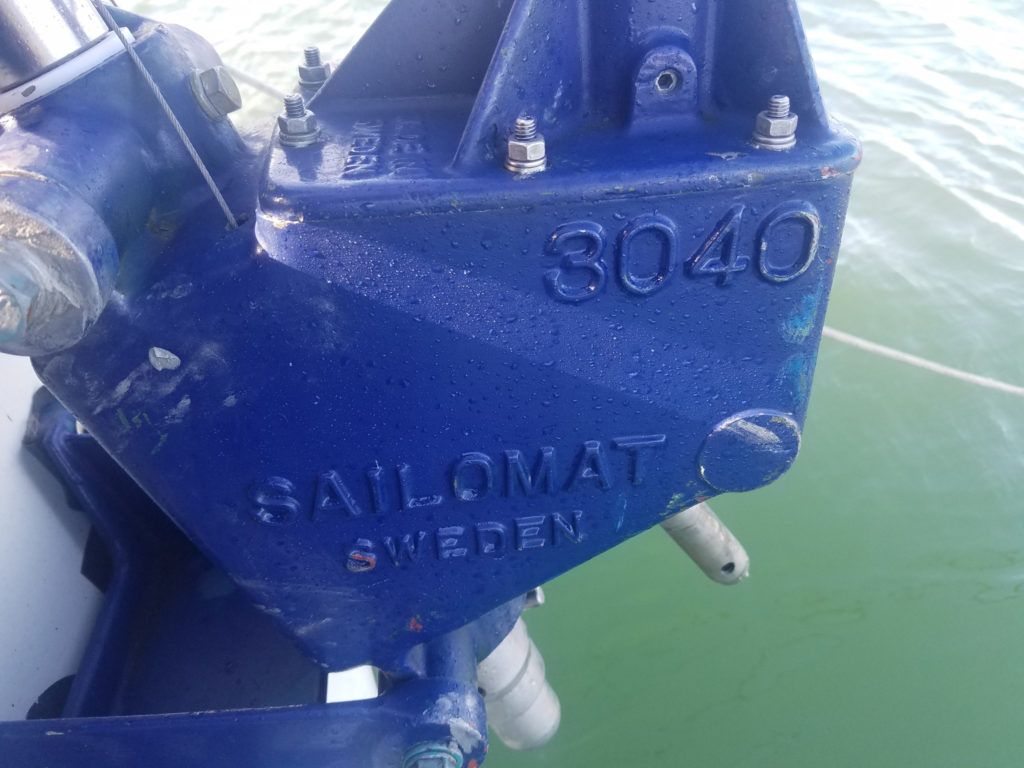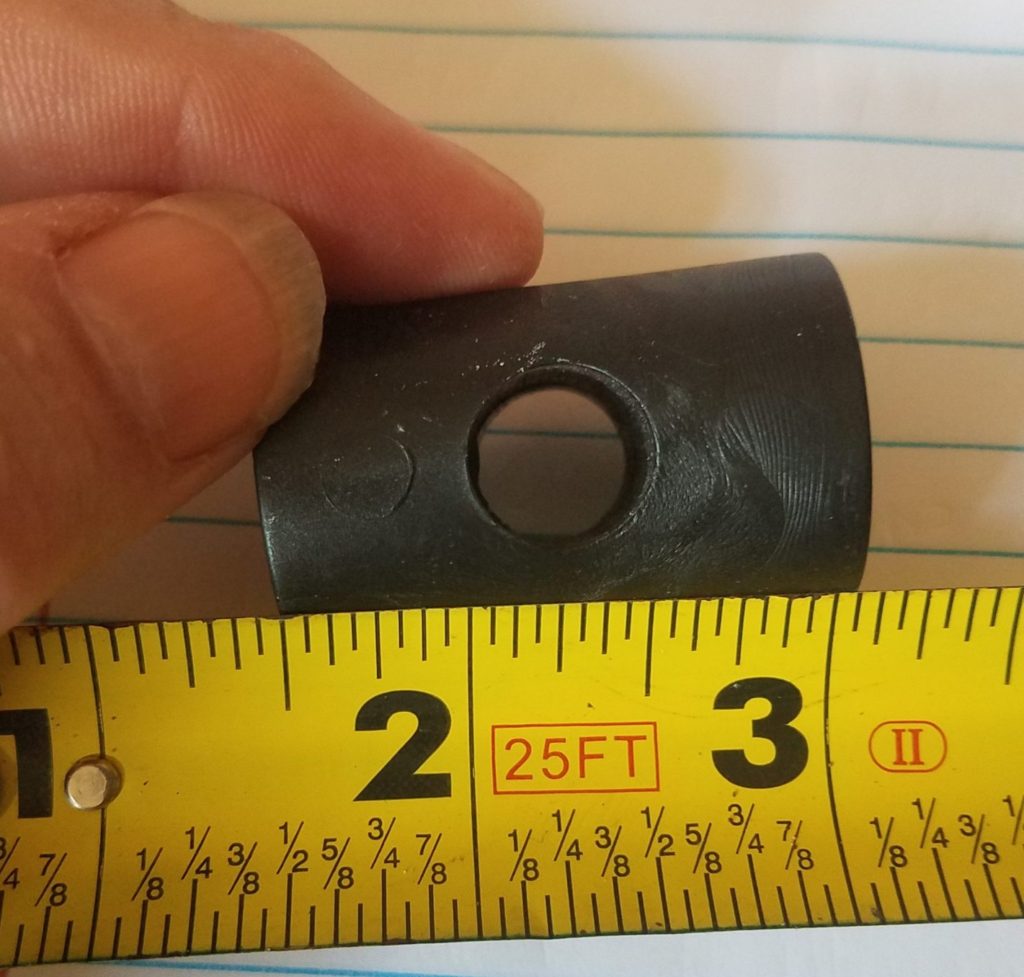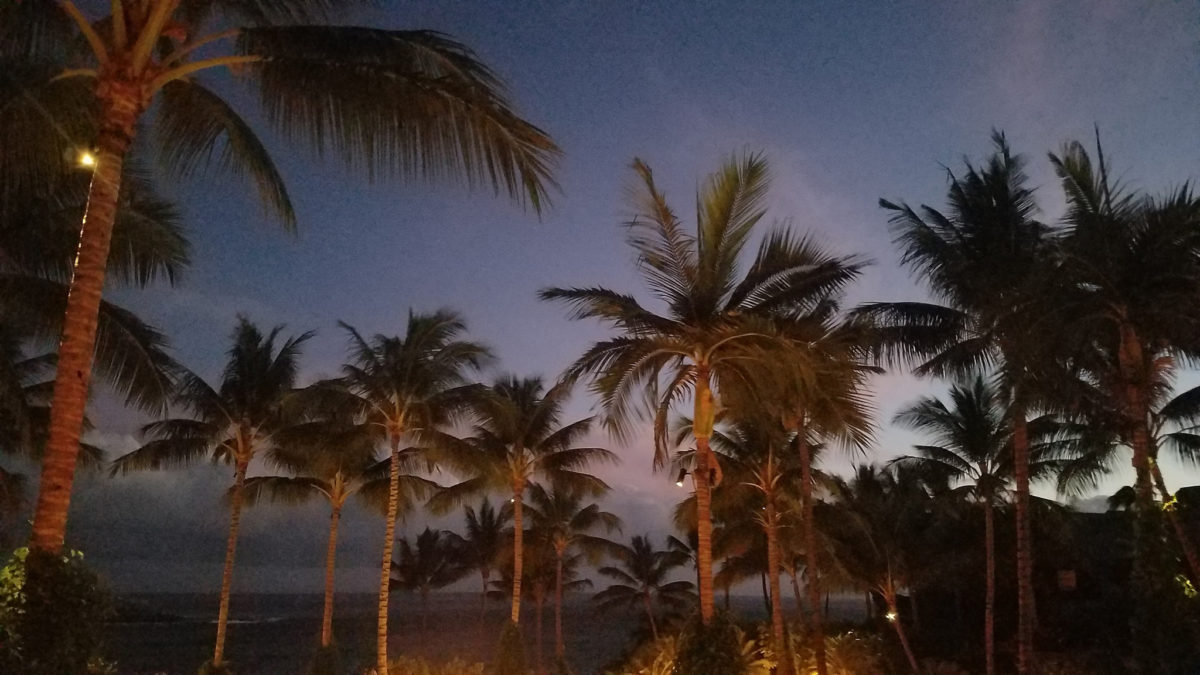19-DEC-2019 – This was written last month. It is more depth on what broke than the most recent post.
Manele Bay, Lana’i Island 11-Nov-2019 – We’ve been in Hawaii a month now. It is a stretch to remember what broke on the passage. Things continue to break as others are repaired.
The major items that broke, and as a consequence changed Jennifer’s view of offshore sailing, were the two self-steering devices.
Fifty miles off Cape Flattery, about eight hours after leaving the Strait of Juan de Fuca, the wind vane self-steering broke, literally broke. When the boat went off course, I looked over the transom: the steering oar had broken off and was trailing by its leash.

I attributed the break to binding inside transmission box, but now with more information it seems to be, as my friend Keith Grundy suggested, metal fatigue. The story of the replacement piece is a separate blog post, but I can’t more highy recommend the father and son at Dynamic Machining in San Diego. They are the last manual (non-CNC) machine shop in San Diego. CNC (Computer Numerical Control) machinery are designed for precision, repetitive tasks, not for one-offs. The setup expenses greatly exceed the cost of just doing the work with calipers and other measurement tools.
The rest of the trip down to San Francisco was without mechanical issues. Learning to be offshore was enough.
In San Francisco, we waited for parts in that exotic city – That is the definition of sailing: waiting for parts in exotic places. The replacement coupling didn’t fit, and we sailed using the electric auto helm, solely, to San Diego.
The was one other thing that did break on the Seattle-San Francisco leg: Let me instill fear in you for these two words, Cast Bronze.
When we started setting up the Portland Pudgy as our life raft, we followed the manufacturer’s directions and installed pelican hooks to attach the life lines to the bow pulpit. The idea, which we have found to work wonderfully, is that the pelican hooks can be easily opened allowing the dinghy to be more easily launched. It works very well.
On the first night out of Cape Flattery, Caro Babbo took an unexpected dip while I was on on the bow. Now I would stand differently, or more likely kneel or sit. But the boat dropped and I was about 15 or 16 inches above the deck. When I came down, my left foot landed on the top most pelican hook, which exploded – remember, cast metal is not maleable.
Both feet landed on the deck and I completed whatever I was on the bow to do, most likely a sail change. (I replaced all the life lines with stainless steel pelican hooks in San Diego.)
In San Francisco, I replaced the diesel starter with a spare I have had on board for six years. I can do without an alternator, we have solar panels to generate electricity, but I have no way to start the engine if the starter fails.
I, for some reason, thought the original Yanmar starter was worth more than a replacement starter and spent way more than $150 having it modified and repaired, twice. The modification was to add a relay because the starter was so far from the starter button that the resistance in the wire dropped the voltage too much to engage the starter solenoid. A good decision. The rest was to repair something that the repair tech never found.
I expect it was a dead spot on the windings and he did not walk through them one-by-one, but when the starter would not spin, it would draw significant current, this may point somewhere else. After living with this flakey started for three years, I replaced the it with a $100 Mitsubishi, which came with a test sheet showing this unit’s performance.
It has worked perfectly, reliably and with great torque.*
By San Diego, we learned that we had nowhere near enough solar to run the electric auto helm, let alone Jennifer’s CPAP machine. So, I ordered a 200-watt flexible panel for the dodger top. This doubled our generation capacity and doubled our output, but it is still not enough to run both. It is enough to run the autopilot 12-hours a day! More about that to come.
I also managed to spend $230 at Fisheries to replace the current life lines, buy new stainless steel pelican hooks, and then supplies: oil, oil filters and 50 ft of line to make be able to put in the third reef in the main. What would a week be like with out a few hundred dollars spent at Fisheries.
The reason for the new life lines was that the uncoated life lines were abrading the genoa sheet. But, then I got careless. When I installed the nicopress fittings for the life lines, I allowed the bitter end of each line to stick out past the end of the fitting. Something I have been smart about in the past. The ragged wire wore two holes in the genoa near the tack.
I also replaced one of the line guides in the mast for the main halyard. These are plastic indents that allow lines to enter an exit the mast (the internal halyards) without abrading. My mast manufacturer, Isomat, is out of business and the only source for parts is a company in the Rhode Island. The parts I receive from them would be politely described as excrement. The guide I bought in San Diego from a reseller was purchased from that company; I paid $32 for a piece of soft molded plastic.*
We left San Diego harbor on a Sunday morning after refueling.
In San Diego Harbor, we found that the rules of the road have been redefined as a game of chicken. No one yielded when we were the stand-on vessel, if they were larger, this included charter vessels with passengers aboard.
Three days out of San Diego, I found the wind vane self-steering gear would not hold us on a port tack. No amount of adjustment would fix the problem, so we switched on the electronic autopilot.
We made very good time under sail, often exceeding 7 knots over the ground. The sound of the spinning propeller through the water starts at six knots and over seven is very loud.
What we hadn’t noticed is that we were getting water into the bilge, which the automatic bilge pump pumped out. Most likely, the shaft seal is leaking slightly. We hadn’t noticed until the float switch failed and bilge filled. Jennifer discovered this when she noticed that the spinning of propeller sounded different.
We pumped by hand using the manual cockpit-mounted bilge pump for two days. The problem with the hand pump is that hose from the bilge to the pump is so long that the hose will hold almost the entire volume of bilge, so the back flow after you stop pumping pretty much refills the bilge.
The float switch problem turned out to be salt water intrusion into some connectors in the bilge. Heat shrink connects well hopefully fix this. Three connectors are above the bilge, so it is unclear how the intrusion happened.
After we finished our crossing, Jennifer watched a number of sailing videos with a new eye. Among the things that had a greater impact than before was noticing that things break on other boats, and the idea of cascading failures, because we were the subject of a cascading failure:
About eight days east of Hilo, the autopilot failed.
The house batteries that run everything except the starter motor were lasting a much shorter time than they had been. Batteries have a lifecycle and I made a note to have our batteries tested and replaced as necessary.
One evening I noticed that the autopilot has moving the wheel less and making less noise. I attributed this to a change in sea state and that I have learned to balance the sails better so that less steering input was necessary.
One night, while running wing-and-wing the autopilot did not keep up in winds that it normally would have (here comes the cascade).
A preventer is a line that runs from the end of the boom to some arbitrary point forward on the deck. We use the furtherest forward stanchion base to keep the boom from swinging from one side of the boat to the other in a jibe†. The snap shackle I used to attach the preventer to the stanchion was, again, cast bronze.
We were both below when we heard the jibe. That it was a jibe was immediately apparent as we ran into the cockpit. But how?
The cast bronze shackle, like the pelican hook exploded. The line for the preventer had sprung back and was looped over the outboard stored on the transom. I would find other pieces of the snap shackle here and there for the next day or two.
As the boom crossed the cockpit, the mainsheet had enough force to break the stainless steel welds on the mainsheet traveler mount and somehow sheer off the port-most nut holding the traveller to the mount.
We didn’t put together that it was the autopilot that failed, instead attributing the failure to a large unexpected wind shift. Two hours later in much lighter winds it happened again, this time dragging the traveller 10 inches to starboard.
I set the traveler car to the center of the traveler mount, so there would be less leverage and the next day attached a long dyneema shackle from the traveler car to the original mainsheet mount on the cockpit table.
By morning we understood what had happened, found that the autopilot could not maintain any course and that the motor was much too hot to touch.
Because we had an Iridium GO, we were able to call our friend and sometime sailing companion, Erwin, who bought a replacement autopilot motor assembly for $700 delivered – to Hilo.
When major things break on Caro Babbo, there is a moment of disbelief, then an assessment of how serious the problem is, followed by a plan of action to fix or remediate the problem. Or so I state the process in business English.
Real time, it is more a call out to Jennifer and the gods asking what just happened. Never mind that Jennifer may be asleep down below. I follow this by loudly announcing to the same gods and Jennifer what the problem is. I am right probably 70% of the time. I repeat this pronunciation several times loudly to see whether Jennifer and the gods agree and whether I, after hearing the problem stated out loud, still believe it. Let’s call this a sanity check.
If I still believe my diagnosis, I again announce the severity of the problem, ranging from not a problem to this is bad. I then explain what will happen if we don’t fix it.
30% of the time I will realize this can’t be the problem or Jennifer, who is generally both polite and diplomatic will indicate that this can’t be the problem and why. Diagnosis can involve all five senses plus crawling on hands and knees in awkward recesses.
Once we agree on the problem and I have enlightened the gods about the problem (Jennifer figures out the consequences faster than I do), I figure out what we will do and then implement it.
Looking back on things I fixed while on the passage, I’m surprised I did them and as easily as I did. I am still a little frozen on a passage – or at least I remember being that way, so I’m surprised that I fixed what I did as easily as I did.
Fixing the wiring for the bilge pump required getting out the electrical tool-and-connector box from the starboard cockpit locker and then cutting, stripping and reattaching wires. They run under the main cabin sole plate. The work is easy, and it wasn’t difficult underway, but overcoming the inertia of not touching anything that could make things worse can be difficult.
Looking back, I think I should have pulled the wind vane transmission off the stern and opened it. I would have found that the fix was merely loosening a set screw and resetting it into the detent. It would have saved us eight days of hand steering. But I didn’t know what the problem was. The fear of losing irreplaceable roller bearings, or dropping the transmission kept me from doing the work.†† It is something for me to think about.
* Ed Louchard (https://www.zephyrwerks.com/) made the sheaves in our mast head after receiving the remarkably poor sheaves from the RI company. Those sheaves used a plastic that when said out load sounds very much like Acetal, but are not and had no bearing surface. I can’t recommend Ed enough for Isomat replacement sheaves. Ed is also making a replacement gooseneck bearing for us.

† A jibe is when the wind moves from behind the mainsail to in front of it, causing the boom to cross that boat, often times violently, referred to as a flying jibe. Flying jibes on larger vessels have killed people.
*The Mitsubishi starter casting broke on the fuel dock at Ko’olina on November 27th.
See that separate post.
†† I always tie a line around the transmission whenever I am installing or removing it, which I generally do alone. But having the line slip off and losing the transmission in a harbor is very different than 1000 fathoms at sea. Knowing what I know now, Monday morning quarterbacking, it is easy to see that I should have repaired it there. Not knowing what the problem was still makes wonder whether I should have been braver.

